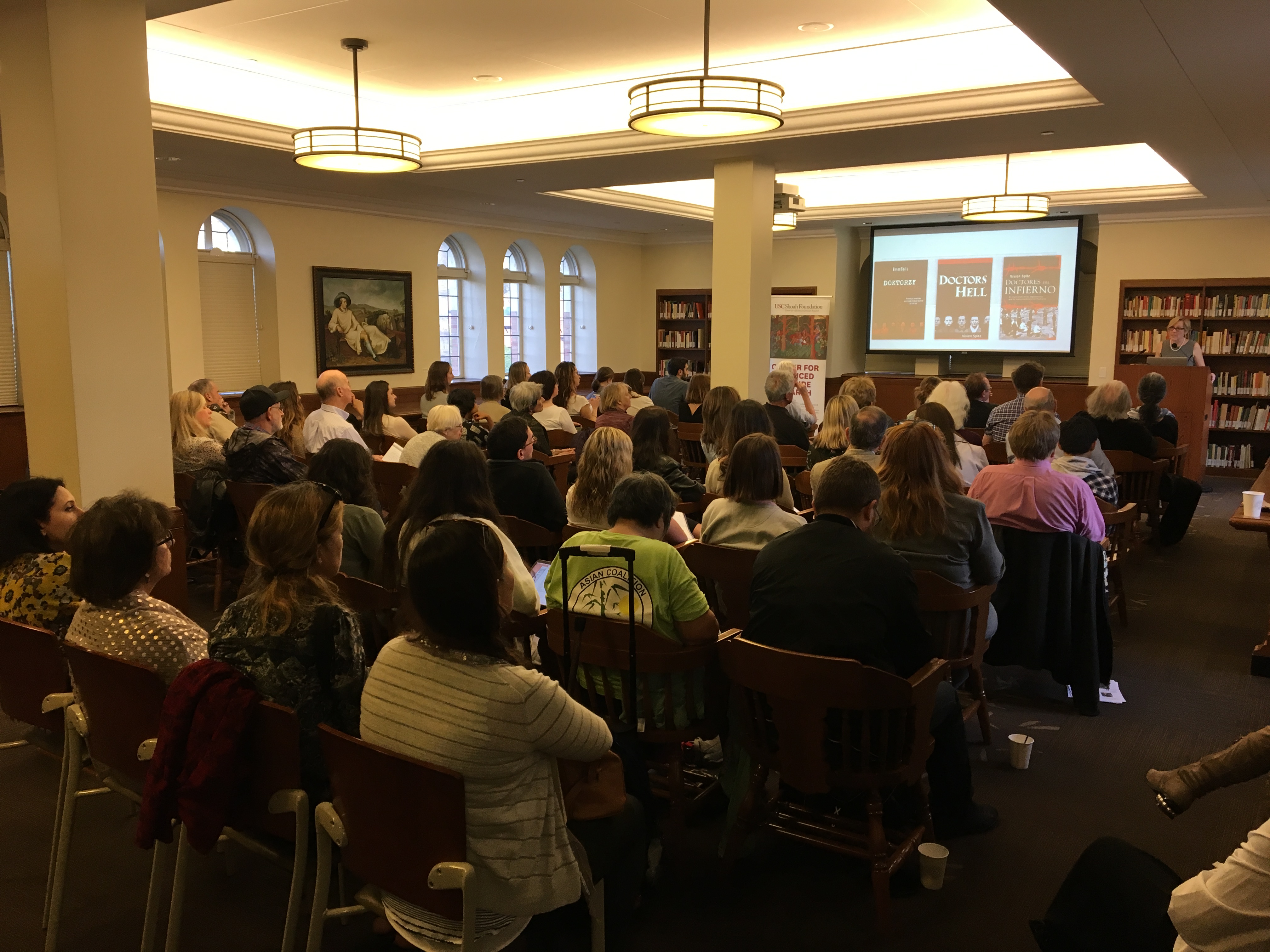Diane Marie Amann Lecture Summary

Diane Marie Amann (University of Georgia and Leiden University, the Netherlands)
2017-2018 Breslauer, Rutman, and Anderson Research Fellow
"Women at Nuremberg"
January 30, 2018
Drawing on USC Shoah Foundation oral history videos, personal papers, and other sources, Dr. Diane Marie Amann's lecture situates stories of the unsung women who played vital roles at Nuremberg in the context of the Nuremberg trials themselves, international law, and the postwar global society.
Diane Marie Amann is the inaugural 2017-2018 Breslauer, Rutman and Anderson Research Fellow.
Diane Marie Amann, the 2017-2018 inaugural Breslauer, Rutman & Anderson Research Fellow, gave a public lecture at the USC Shoah Foundation Center for Advanced Genocide Research. Amann is the Emily & Ernest Woodruff Chair in International Law and Faculty Co-Director of the Dean Rusk International Law Center, School of Law, University of Georgia and also a PhD candidate in Law at Leiden University, the Netherlands. With her dissertation project, she is focusing on the exploration of women’s roles during the Nuremberg Trials after World War Two. Amann endeavors to reveal a story about the women at Nuremberg that counters the dominant narrative about the trials as primarily white, male, and elitist project.
Amann began her lecture by reminiscing about her initial encounter with the women of the Nuremberg trials, which consisted of the International Major War Crime Trial and 12 subsequent trials undertaken by the US occupying forces (1945-1949). While skimming through a book about the trials at a bookstore at Nuremberg, she found photographs that featured some women and was curious to discover who they were and what roles they played during the trials. Her curiosity was especially piqued, because men have written and dominated much of what we do know about Nuremberg. In addition, Amann pointed out, the perception of the Nuremberg trials as a “male thing” is deeply ingrained in our culture. As an example, Amann reflected on the 1961 motion picture Judgment at Nuremberg, in which the only two women featured in the movie are represented as a love interest and a female victim. In her project, she aims to excavate other roles the women played in the trials.
During her month-long stay at the USC Shoah Foundation Center for Advanced Genocide Research, Amann discovered, watched, and analyzed 24 testimonies from the Visual History Archive by individuals that participated in the Nuremberg trials. In addition to these newly-found invaluable sources, her project relies on court documents, memoirs of the war, as well as personal papers in possession of the descendants of these female participants.
As part of her lecture, Amann shared many stories from the testimonies she consulted during her stay. These included the testimony of Cecelia Goetz, an associate counsel in the Krupp trial, who was the only US woman prosecutor to give an opening statement at the trial, as well as the testimony of Vivien Spitz, a court reporter on the so-called Doctor’s trial, who ended up being the only woman involved in the Nuremberg trials who subsequently wrote a memoir about her time there. Other testimonies Amann reflected on included those of Jane Lester, a research analyst and personal assistant to Robert Kempner; Edith Simon (Coliver), an interpreter and research analyst; and Harriet Zetterberg (Margolies), an attorney on the US prosecution staff, who were all involved in the major war criminals trial and subsequent trials. In addition, Amann also mentioned women on the “other side,” namely Dr. Elisabeth Gombel, a defense attorney for E. Bohle, and Dr. Herta Oberheuser, the only woman convicted as a perpetrator for her crimes at Nuremberg, as well as a witness Wladyslawa Karolewska, who was subjected to medical experiments during the Holocaust.
Besides sharing details from the testimonies she worked with, Amann highlighted the interdisciplinary nature of her project, which draws from the fields of history, historiography, memory studies, and international law. In particular, Amann pointed out that her project is not only a gender studies project, but that her primary interest lies in the cross-cutting identities these women possessed. These include not just sex and/or gender, but also race, nationality, ethnicity, religion, as well as class, socioeconomic status, and education. In this sense, Amman’s findings reveal that class mattered a great deal and altered people’s experiences at and their memories of the trial. Amann noted that many of these women were forced into feminine roles, and were often seen as inferior to elite, highly educated white men that dominated the trial. Even when the women did earn attention for their work, newspapers presented them in very gendered ways – for example, photographed showing lots of leg.
Returning again to the testimonies, Amann argued that the VHA testimonies are extremely valuable for her research, as women tend to be more candid in their interviews when compared to what is usually said about the differing experiences of the Nuremberg trials. The testimonies are invaluable, Amann explained, because by now, only two of the women she is researching remain alive now. Through the testimonies, she can hear from them about their experiences and their significant contributions to the Nuremberg trials.
Amann’s lecture was followed by a lively discussion that encompassed many topics and allowed Amann to expand on issues she had addressed briefly during the lecture, including the selection criteria for women on the prosecutor’s team; the avenues of interaction between women on the prosecution and defense sides; the living conditions in Nuremberg during the trials; the impact of McCarthyism on the trials and trajectories of people’s careers afterwards; Amann’s reflections on Visual History Archive interviews; and the question of the overall success of the Nuremberg trials.
Summary by Badema Pitic